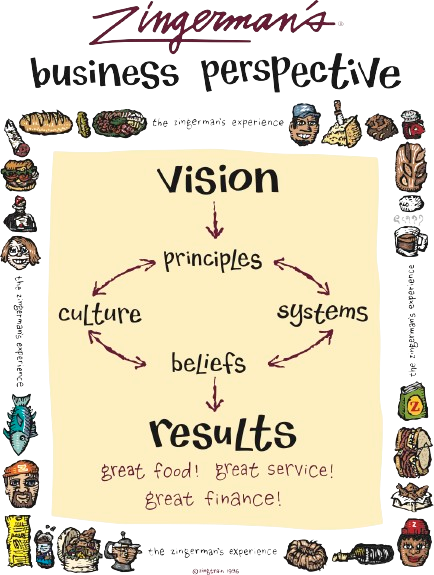Training Tool: Business Perspective Chart
The Business Perspective Chart, or the BPC, is one of our very favorite training tools at Zingerman’s. Why do we love it so much? It provides framing and context for how our business operates and why, and it gives us a common language to use when talking about the business. This is especially helpful when we’re training staff internally, or when we’re teaching our business practices to other organizations. Created by ZingTrain’s Founder, Maggie Bayless, in our early days, the BPC is a visual representation of how Zingerman’s operates.

Many businesses we’ve worked with have adapted the Business Perspective Chart to suit their needs, and you may want to do the same! Let’s walk through it together:
Mission Statement
The colorful border around the chart represents the Zingerman’s Mission Statement. The first line of our mission statement states, “We share the Zingerman’s Experience,” and it is the reason we all show up to work every day. We don’t come to cook food, or make coffee, or train people – we come to work to deliver an experience. Providing a Zingerman’s Experience quite literally frames all the work we do on a daily basis!
Vision
At the top of the chart is Vision. A vision is a picture of what success looks like at a particular point in time, written with enough richness of detail that you can picture it happening. As an organization, Zingerman’s has a vision for the year 2032 (the year Zingerman’s Deli turns 50 years old). Every business within Zingerman’s Community of Businesses also has a vision of success, as do many departments within each of those businesses. We also use visioning whenever we propose a change (big or small) or when we roll out a new project. And! Many employers here at Zingerman’s have even written personal visions. Having a vision gets everyone on the same page, moving in the same direction, and aligns us all around the same definition of success.
Bottom-Line Results
At the bottom of the chart are Bottom-Line Results. At Zingerman’s, we measure success based on three bottom lines – food, service, and finance. Many organizations choose to measure success on one bottom line – finance. Finance is certainly important to us – without money, we can’t stay in business! But great service and great food are just as important. And we are explicit – we don’t give great service just to have great finance – giving great service is an end in itself. The challenge with three bottom lines, however, is that they can be in conflict with each other. For example, at the Deli, it would be really great service to their customers to add more staff to the retail floor, but finance would suffer from the increase in employee wages. We work hard to make a concerted effort every day to balance all three bottom lines!
Principles
At the center of the chart are our Principles, which represent our values and ethics. At Zingerman’s, our Guiding Principles define how we behave and interact with those around us as we work toward our long-term vision and mission. We have nine guiding principles, including Great Place to Work, Great Place to Shop and Eat, and Strong Relationships.
Beliefs
Below Principles are Beliefs. Zingerman’s has documented 34 agreed-upon beliefs that help us make effective decisions that are aligned with our Principles. For example, one of our beliefs is that we need our customers more than they need us. This means that we don’t take any customer interaction for granted, and we go out of our way to re-earn our customers’ trust every day.
Systems
To the right of our Principles are Systems. Systems are what we say we do – also known as rules, policies, or Standard Operating Procedures (SOPs). We create systems to achieve consistent results that align with our vision of success. Systems aren’t created to get in the way of our work or to make things difficult for our customers.
Culture
To the left of Principles is Culture. There are many definitions of organizational culture, but in this context, if systems are what we say we do, culture is what actually happens. It’s the personality of the organization. Culture is what happens in the office, or on the floor, when the manager isn’t looking.
Ideally, culture is closely aligned with the systems, but we know that’s not always the case. The discrepancy is what we refer to as a Systems-Culture Gap.
The Systems-Culture Gap
Say you learn a 4-step process for completing a task, but when you’re following the process, your coworker next to you says, “I know you were told to follow all 4 steps, but no one really does step 4 – just skip it and we can leave early!” The next day, you’re instructed to train someone else, and you say, “I know the person yesterday said we can skip step 4, but I think step 4 is important! Step 2 is another story…. Feel free to skip it when I’m here.” This can worsen over time, and typically, the person who suffers the most is the customer who isn’t receiving any consistent service.
The Systems-Culture Gap is particularly challenging for new employees – they want to do a good job, but have no idea how because success is a moving target. What if two managers are working at the same time, each of whom follows different systems? How is the new employee supposed to know which system to follow?
Fixing a Systems-Culture Gap
What’s valuable about teaching the Systems-Culture Gap is that it provides neutral language that allows everyone to identify the gap that exists and then work together to close it. Is the system correct, and culture needs to be brought into alignment? If so, we might work on more training or holding people accountable when they fail to use the system. Is the system now obsolete and no longer useful? Then we need to update the system to reflect the current culture. This is part of what we explicitly teach to every Zingerman’s employee, regardless of their position – it’s incumbent on each of us to help close that gap. It’s not okay to walk away from the gap, hoping that someone else will work to close it!
These gaps still exist at Zingerman’s – we certainly aren’t perfect! What sets us apart, however, is that we have a common language to talk about these gaps, as well as the expectation that we’ll call out the gaps and work together to close as many of them as we can.
Using the Business Perspective Chart
By using the Business Perspective Chart internally and in our workshops, we’ve found that people better understand the impact their actions have on bottom-line results. They also feel more empowered to call out Systems-Culture Gaps. When people know what to do when they encounter these gaps, we can operate more consistently, ensuring our results are more likely to match our vision of success.
 Back to Library
Back to Library




